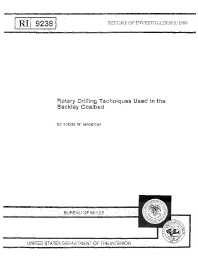Mining Publication: Rotary Drilling Techniques Used in the Beckley Coalbed
Original creation date: January 1989
The U.S. Bureau of Mines used a contact drilling strategy with short- collared assemblies in order to rotary drill long horizontal methane drainage holes in the Beckley coalbed near Glen Daniel, West Virginia. By decreasing the thrust and increasing the rotation of the drill bit when in contact with the roof and floor rock, assemblies with 1-ft (0.3-M), 10-ft (3-m), and 14-ft (4.3-M) long collars were made to deflect and stay in the coalbed. Successful application of this procedure resulted in holes drilled full length in coal with the original assembly including bit. The test assemblies deflected away from the original bearings of the holes during drilling and arced. Four holes were drilled to depths ranging from 478 ft (145.7 M) before the strategy was developed, to 4,034 ft (1,230 m) when the strategy was applied. Total length of the holes in coal was 8,590 ft (2,618 m). After 577 days the total methane captured by the holes was 221,600,000 ft3 (6,276,000 m3). The methane flow rate peaked at 805,000 ft3/d (22,798 m3/d), then decreased to stabilize at 670,000 ft3/d (18,974 m3/d) after 6 months.
Authors: TW Goodman
Report of Investigations - January 1989
NIOSHTIC2 Number: 10006977
U.S. Department of the Interior, Bureau of Mines. Report of Investigations 9238, NTIS No. PB89-201347, 1989; :1-11
See Also
- A CART Technique to Adjust Production from Longwall Coal Operations under Ventilation Constraints
- Coal Mine Methane: A Review of Capture and Utilization Practices with Benefits to Mining Safety and to Greenhouse Gas Reduction
- Composition Change Model for Sealed Atmosphere in Coal Mines
- Historical Development of Technologies for Controlling Methane in Underground Coal Mines
- Methane Control by Isolation of a Major Coal Panel - Pittsburgh Coalbed
- Methane Control for Underground Coal Mines
- Methane Emissions from Four Working Places in the Beckley Mine, Raleigh County, W. Va.
- NIOSH Research for Monitoring and Controlling Methane at U.S. Underground Coal Mining Operations
- Peak Methane Concentrations During Coal Mining: An Analysis
- Removing Methane (Degasification) from the Pittsburgh Coalbed in Northern West Virginia
- Content source: National Institute for Occupational Safety and Health, Mining Program


 ShareCompartir
ShareCompartir
